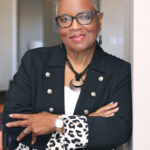PUBLISHED JULY/AUGUST 2020
by
Deb Vanasse, Reporter,
IBPA Independent magazine --

Deb Vanasse
Independent publishers cope, adjust, and hope for a better future during COVID-19.
Article Synopsis:
- The pandemic forced the closure and cancellation of many events independent publishers and authors rely on.
- Independent publishers have the flexibility, resilience, and innovative spirit needed to weather a crisis.
- Change is a given, but what pandemic-driven changes will outlast the crisis?
Starting up a publishing venture can be challenging in the best of times. But
Stormbird Press got slammed with circumstances well beyond the norm.
Director Margi Prideaux and her husband launched the nonprofit press out of their farm on Australia’s Kangaroo Island. In January, the wildfires that devastated Australia swept through their property, destroying the Prideaux home as well as Stormbird’s offices, stock, and business infrastructure.

Margi Prideaux
As a startup, Prideaux says her team was “already at the ragged edge, struggling to release enough titles to keep booksellers interested in us.” Emerging from a two-month work stoppage following the fire, the company was “cash-strapped” and looking for ways to promote its titles while cutting costs.
Then COVID-19 hit, forcing yet another reset. “But we are not daunted,” Prideaux says. “Growing stronger from this adversity is our focus this year.”
Canceled, Closed, Confined
Throughout the industry, COVID-19 has presented challenges no one could have anticipated at the beginning of the year. Festivals, conferences, and author events were canceled. Bookstores and libraries closed. Staff were forced to work from home.

Sam Hendricks
Sam Hendricks, publisher at
Kyanite Publishing, reports an 80% decrease in print sales and a 50% increase in digital sales. The pandemic also forced Kyanite to delay new releases. “We’ve had events canceled and decided not to attend some in the fall,” Hendricks says.
As sales slowed, publisher Peter Goodman of Stone Bridge Press canceled some author advances. Rather than chase new accounts, he focused on nurturing those his company already had. The pandemic also upended forecasting models.
“I’ve spent more time fretting about revenue issues and what to do with employees and freelancers, but it’s not like I’ve got any tools to project the future,” Goodman says. “I have become way less likely to approve unsigned projects moving forward.”
Even publishers with titles that performed well in the stay-at-home circumstances had trouble adjusting. “Our niche, kids’ activity books, have dominated the top sellers on Amazon,” says Wendy Piersall, CEO of
Woo! Jr. Kids Activities. “At one point, over 70% of the top 100 books were kids’ activity books.”
As her company’s sales tripled, Piersall expects competition within the niche to increase. At the same time, she reports a decline in productivity as employees juggled demands of work and home. The solution, she says, may include switching from hourly wages to project-based work.
In the school market, the pandemic has shifted the playing field in favor of larger companies, says Walton Burns, senior editor at
Alphabet Publishing. “Some larger companies have been pouring resources into online platforms that are normally used in schools but can easily be adapted for school from home,” he says. “And, of course, those companies are giving access away, reaching even larger customer bases now.”
Canceled conventions have also tipped the balance in favor of Alphabet’s largest competitors. “Those are major events for getting your name out there and meeting the administrators at schools who are often hard to get to unless you have a nationwide sales team,” Burns says. “The big guys have those. We indies do not.”
The Indie Advantage
Big companies may have big resources, but independent publishers have the flexibility, resilience, and innovative spirit needed to weather a crisis.
With characteristic nimbleness, Burns responded to the slump in school sales by ramping up a move into subsidiary products in the form of lessons that teachers can download, print, and photocopy through online sites. Another plus: The company’s freelancers were already accustomed to working at home. “There’s been a lot of humor about how we’ve designed our whole lives for this,” Burns says.

Stormbird went from releasing four titles at a time to single releases that get full marketing attention for two months before the next title comes out. “We’re hoping greater reader interaction built into the post-release period will develop deeper commitment to our authors, their messages, and our titles,” Prideaux says. “If our plans work, we’ll release fewer books each year but have deeper investment in each. We think this may also be more sustainable for our small team to manage.”
Likewise, Kyanite’s delay in new releases has prompted Hendricks to pivot toward strategies that she believes will ultimately improve the company. “We are taking more time on each title, doing more up-front marketing planning, and changing our relationship to the business in important ways that provide us more work-life balance and higher efficiency,” she says.
Another positive was the creation of an author advisory board, which in turn led to author-created working groups to take on big projects such as video production. As a result, Hendricks says, “We feel closer to, and more transparent with, our authors than ever before. Our new author advisory board and working groups have been a great source of support, inspiration, and knowledge for us.”
Disruptive as it has been, the crisis has presented many silver linings, Hendricks says. “We’ve had more readers reach out via email for ARC copies and free content. We’ve seen increases in our social media reach and engagement. And re-evaluating our catalog and new release strategies have created a forum for us to pivot in many ways we needed to, empowering us to take time to learn more before acting,” she says.
At
Foster Embry Publishing, CEO Maggie Amanti notes improved workflow and focus during the stay-at-home period, in part because submissions decreased. “It has allowed us more time to work with our current authors,” she says, adding that the Foster Embry team “certainly has come together” during the pandemic.
Into the Future
In independent publishing, change is a given. The question now is which pandemic-driven changes will outlast the crisis.
Amanti suspects that even as the crisis wanes, online sales will retain an advantage over brick-and-mortar retail, causing publishers to further adapt. “We have already started ramping up our sales team to ensure we are utilizing resources in an intelligent fashion, in order to not waste time and money on scam advertising or low-yield avenues,” she says.
Another long-term effect may be less outsourcing, says Hendricks, as publishers generate more audio and video content in-house. She also predicts that small companies will become more selective in their acquisitions. At the same time, she hopes publishers will offer authors more flexible contracts and terms.
Goodman expects the pandemic to force yet another winnowing of independent booksellers. “Those that survive will have demonstrated that their community will support them and that the managers are adept at survival and innovation,” he says. At the same time, he notes that Amazon’s prioritization of groceries over books during the worst of the crisis opened a window for competitors.
Recently launched as an Amazon alternative,
Bookshop did indeed ship books faster than the retail giant during much of the lockdown. But Bookshop founder Andy Hunter believes his customers care less about delivery times than they do about supporting independent bookstores, which receive a percentage of the company’s profits.
“There are some stores who are using us for all their sales [during the lockdown], who are telling us we are enabling them to survive the crisis,” Hunter said during the lockdown. “There are other stores for whom we are just one piece of their strategy, bringing in supplemental revenue. We are happy to be helping stores in any way we can.”
Changes to the ways people buy books portend changes in how publishers print them, Goodman points out. He predicts a big shift to print on demand, with wholesalers expanding services that “better accommodate a complete vertical integration of the business.”
Goodman also expects a surge of authors publishing their own work. “With people out of jobs and with more time at home, more books are bound to emerge,” he says. “This is not necessarily a good thing, as it dilutes the marketplace and may again create an unfortunate line between ‘real’ and ‘hobby’ publishing. How will quality and standards be controlled?”
At the same time, the shift to doing everything online has created efficiencies that publishers may well embrace going forward. “Virtual book marketing and promotion will continue because their advantages are clear, particularly now that consumers have made themselves available and amenable,” Goodman says. “It’s hard to get a dozen people to a bookstore, but you can easily get many dozens online. Even if you don’t, you’re not out all the travel and logistics costs.”
The adjustment to working from home has prompted Stone Bridge to consider whether they even need an office. Shuttering a workplace may save money and time, but Goodman wonders about the intangible effects of siloed workspaces. “Will important synergies be lost and important projects become less than what they could have been?” he asks.
Yet in sum, Goodman expects the changes to be for the best. “The book biz has been positively prehistoric in its practices,” he says. “It needs a kick in the butt.”
Resolved
Whatever the changes wrought by the pandemic, publishers find clarity and strength by grounding their work in what matters most.
“The wildfires and then the pandemic have forced us to refocus on why we are publishing books in the first place,” Prideaux says. “Certainly, we want to generate enough income to survive, but our primary objective is to get good stories that defend nature and empower communities into the hands of readers across the world.”
Amanti agrees that the focus can’t be simply on economics. “We must care for each other—our authors, our team, our communities,” she says. “A new reality is being defined before our very eyes, and we welcome lessons we need to learn, even if they do cause some growing pains in the meanwhile.”
At Kyanite, the pandemic allowed Hendricks and her staff time to make “overdue” updates to the company’s mission statement, business plan, and procedures. She urges publishers to look for such silver linings wherever they can.
“It’s okay to have good things happen during bad times,” she says. “It’s okay to feel more motivated and inspired than ever, even if we’re suffering or watching someone else suffer. We need art, and we need to witness the immense power and beauty of the human spirit now more than ever.”

Willa Robinson
In this spirit, Willa Robinson, publisher at
KP Publishing Company/Knowledge Power Books, returned to work after her husband succumbed to COVID-19 at the end of March. Even as she went through a “grieving season,” she moved forward with the books they had in the pipeline.
Robinson urges publishers not to squander the opportunities that arise from adversity. “It’s a time to adjust. All that’s broken, take this time to fix it, remove it, or destroy it,” she says. “It’s time to take action to help others. Something good and positive is coming from this pandemic.”
Innovations
Independent publishers responded to the pandemic with characteristic agility and creativity. Here, we highlight some of their innovative efforts. For more ideas and resources, visit
IBPA's COVID-19 Resource Center.
Healing Words Project: Recognizing the value of escapism in troubled times, Kyanite Press created the Healing Words Project, an online column where their authors post stories offering a distraction from pandemic news.
Facebook Live Events: As in-person events shut down,
Running Wild Press executive editor Lisa Kastner began recording weekly Facebook Live events where she answers reader questions. “I’m seeing an uptick in attendance and in folks forwarding the finished recording,” she says.
Stay at Home Resource Kit: When the local library canceled her Women’s History Month Program,
Ida Bell Publishing owner Wendy Jones created a “Stay at Home Resource Kit,” distributed electronically to readers on her email list. The kit includes inspirational quotes from African Americans emphasizing the importance of strength during adverse times, biographies of little-known but historically important African Americans, and links to sites featuring African American literature, history, art, and science.
Tiny Book Fest: With book tours, conventions, and festivals “essentially erased,”
Interlude Press and
Duet Books scheduled a video-based Tiny Book Fest that featured author chats, panels, giveaways, and special guests. “In these times, it’s all about engagement in readers’ homes and being creative about how to reach them,” says co-publisher Candysse Miller.
Virtual Lessons: When the pandemic struck, educational children’s book publisher Jo Meserve Mach of
Finding My Way Books was already offering book-linked lessons for download at a third-party site. As schools closed, she created social-emotional learning activities to help children and families handle pandemic-related stress and made them available for download direct from her company’s website.
Deb Vanasse is the author of 17 books. Among her most recent are the novel Cold Spell
and a biography, Wealth Woman: Kate Carmack
and the Klondike Race for Gold
. She also works as a freelance editor.